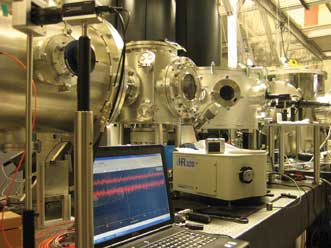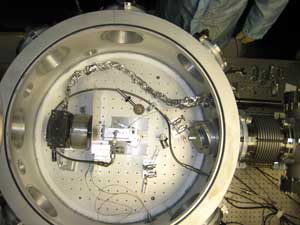
Tabletop device accelerates electrons to 2 GeV
Until recently, if you wanted to speed up electrons to 2 gigaelectron volts (GeV), you needed a multimillion-dollar accelerator nearly 200 m long. But not anymore: Now you just need a tabletop device.
“We have accelerated about half a billion electrons to two gigaelectron volts over a distance of about one inch,” said Mike Downer, professor of physics in the University of Texas at Austin’s College of Natural Sciences. “Until now, that degree of energy and focus has required a conventional accelerator that stretches more than the length of two football fields. It’s a downsizing of a factor of approximately 10,000.”
The electrons from the current 2-GeV accelerator can be converted into “hard” x-rays as bright as those from large-scale facilities, Downer said. He believes that, with further refinement, they could even drive an x-ray free-electron laser, the brightest scientific x-ray source currently available.
A tabletop x-ray laser would be transformative for chemists and biologists, who could use the bright x-rays to study the molecular basis of matter and life with atomic precision, and femtosecond time resolution, without traveling to a large national facility.

This tabletop setup at the University of Texas at Austin accelerated approximately half a billion electrons to 2 GeV over a distance of about 1 in. It’s a feat that previously required a conventional accelerator longer than two football fields. Photo courtesy of Rafal Zgadzaj.
“The x-rays we’ll be able to produce are of femtosecond duration, which is the timescale on which molecules vibrate and the fastest chemical reactions take place,” he said. “They will have the energy and brightness to enable us to see, for example, the atomic structure of single protein molecules in a living sample.”
The idea of laser-plasma acceleration was conceived in the late 1970s by former UT Austin physicist Toshiki Tajima and the late UCLA physicist John Dawson. While scientists have been experimenting with the concept since the early 1990s, they’ve been limited by the power of their lasers. As a result, the field had been stuck for years at a maximum energy of about 1 GeV.
Downer and colleagues used laser-plasma acceleration to generate electrons energetic enough to produce x-rays; the method involves firing a brief but intensely powerful laser pulse into a puff of gas, which ionizes the gas and creates a plasma.
“It also imprints structure in it,” Downer said. “It separates electrons from the ion background and creates these enormous internal space-charge fields. Then the charged particles emerge right out of the plasma, get trapped in those fields, which are racing along at nearly the speed of light with that laser pulse, and accelerate in them.”

The interior of the vacuum chamber in which the acceleration occurs. The laser beam arrives from the right. The gas cell, within which the acceleration of electrons occurs, is in the center of the chamber. The actual acceleration occurs over a distance of about an inch. Photo courtesy of Neil Fazel.
Using the Texas Petawatt Laser, the team could use gases that are much less dense than those used in previous experiments.
“At a lower density, that laser pulse can travel faster through the gas,” Downer said. “But with the earlier generations of lasers, when the density got too low, there wasn’t enough of a splash to inject electrons into the accelerator, so you got nothing out. This is where the petawatt laser comes in. When it enters low-density plasma, it can make a bigger splash.”
Now that the workability of a 2-GeV accelerator has been demonstrated, Downer said he expects 10-GeV accelerators – capable of doing the x-ray analysis desired by biologists and chemists – to be developed within the next few years.
“I don’t think a major breakthrough is required to get there,” he said. “If we can just keep the funding in place for the next few years, all of this is going to happen. Companies are now selling petawatt lasers commercially, and as we get better at doing this, companies will come into being to make 10-GeV accelerator modules. Then the end users – the chemists and biologists – will come in, and that will lead to more innovations and discoveries.”
He said he also believes that 20-GeV accelerators of similar size – a few centimeters long – could be developed within a decade.
The results were published in Nature Communications (doi: 10.1038/ncomms2988).
Published: September 2013